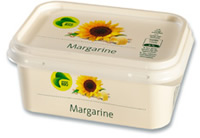|
Syllabus ref: 11.3 Syllabus ref: 21.1 In a hydrocarbon, where all the C atoms have only single bonds and no rings are involved, the compound would have the maximum number of hydrogen atoms attached to the carbon atoms. If any of the single carbon-carbon bonds are replaced with double or triple bonds (or if rings are involved) there would be a “deficiency” of H atoms. By calculating the index of hydrogen deficiency (IHD), we can tell from the molecular formula whether and how many multiple bonds and/or rings are involved. IHD is also called the Degree of Unsaturation. |
|
This refers to the ability of a molecule to add more hydrogen. This is usually due to the presence of double bonds:
CH2=CH2 + H2
![]() CH3CH3
CH3CH3
The ethene molecule in the equation above is said to be unsaturated; it is able to add one molecule of hydrogen.
The opposite term, 'saturated' means that a molecule is unable to add any more hydrogen as it does not have any multiple bonds.
The index of hydrogen deficency (IHD) is similar to the concept of unsaturation with one important difference - it includes cyclic systems (rings).
Here is a summary of how the index of hydrogen deficiency works.
- 1 A double bond and ring each counts as one IHD.
- 2 A triple bond counts as two IHD.
Hydrocarbons (CxHy):
In a saturated hydrocarbon the number of hydrogen atoms = (2x + 2), when the number of carbon atoms is x.
Hence, the number of hydrogens 'missing' is given by (2x + 2) minus the actual number of hydrogens.
And the number of double bond equivalents is half this value (as a double bond has two fewer hydrogen atoms). Hence the Index of Hydrogen Deficiency is given by:
IHD=[(2x+2)-y)]/2
(where x and y stand for # of C and H respectively.)
This information is then used to determine the number of possible double bonds or rings in the molecule under analysis.
|
Example 1 IHD for C2H4 is [(2*2) + 2 - 4]/2 = 1 This means it can have either one double bond or one ring, but it cannot have a triple bond. Since you cannot form a ring with only two C’s, it must have a double bond. |
|
Example 2 IHD for C4H6 is [(2*4) + 2 - 6]/2 = 2 This means it can have either one double bond and a ring such as or two double bonds such as CH2=CH-CH=CH2 or CH2=C=CH-CH3 or two rings, or one triple bond, such as CH3C=CCH3. |
Combining the index of hydrogen deficiency with the iodine index (unsaturation only) allows us to determine whether the molecule has one or more ring systems.
Many organic molecules contain atoms other than carbon ad hydrogen. They are known, collectively, as heteroatoms, i.e. atoms that are different to carbon and hydrogen.
Oxygen
Oxygen atoms do not affect the index of hydrogen deficiency. In other words you can forget them when carrying out the calculation.
Nitrogen
Nitrogen atoms form three bonds, so for each nitrogen atom you must add one (as you would expect to squeeze one more hydrogen atom into the structure).
|
Example 3 IHD for C2H7N is [(2*2) + 2 - 7 + 1]/2 = 0 This means that there are no double or triple bonds and no ring systems. |
|
Example 4 IHD for C3H5N is [(3*2) + 2 - 5 + 1]/2 = 2 This means that there are either:
|
Halogen atoms, Fluorine, Chlorine, Bromine & Iodine
These are treated as if they are hydrogen atoms and subtracted in the equation.
|
Example 5 IHD for C3H5Cl is [(3*2) + 2 - 5 - 1]/2 = 1 This means that there is either:
|


